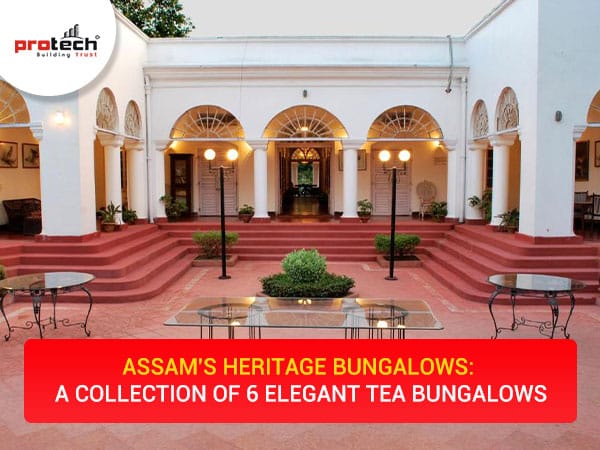Introduction
Our Assam has the beautiful landscapes of Assam, are famous not just for their natural charm but also for the unique tea-growing culture that has flourished here. This article explores Assam’s rich tea heritage, highlighting a few of the magnificent heritage tea bungalows, which can form our bucket list of travel destinations for 2024
Top 6 Heritage Tea Bungalows in Assam
1. Kaziranga Golf Resort, Jorhat
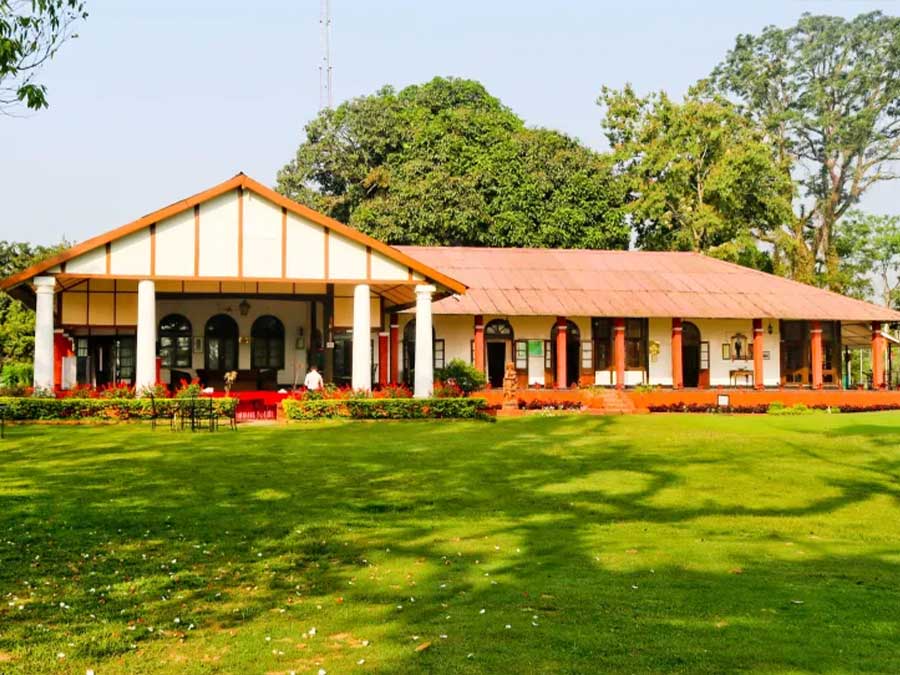
Kaziranga Golf Resort, also known as Burra Sahib’s Bungalow, is a 125-year-old heritage bungalow within Sangsua Tea Estate. The bungalow was originally used as a Visiting Agent’s bungalow by George Williamson. It was constructed with steel imported from the UK.
Today, the club house stands as a distinguished haven for those who are looking for a luxurious and serene escape. Recognized for its outstanding golf course, the resort caters to golf enthusiasts seeking a challenging setting. The 10,000 sq. ft. resort’s design seamlessly integrates modern amenities with the natural charm of Jorhat, drawing inspiration from Assamese traditions to embody the region’s cultural richness. The architecture and landscaping contribute to an ambiance of refinement and tranquility, establishing Kaziranga Golf Resort as a notable retreat in the heart of Assam.
Kaziranga Golf Resort boasts of a deluxe heritage room for accommodation of guests, a Lounge with DTH, fine dining restaurant, wellness center, gymnasium, swimming pool, well stocked bar, library, pool table and various indoor games.
2. Mancotta heritage tea bungalow
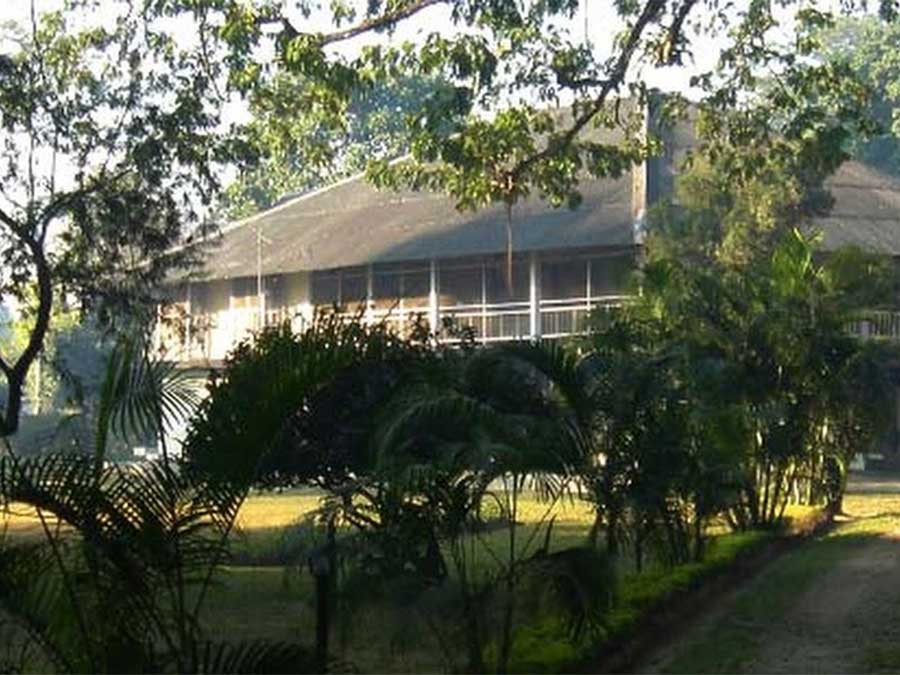
The Mancotta Heritage Tea Bungalow, situated inside the Mancotta Tea Estate in Dibrugarh, offers a charming blend of colonial-era charm and Assam’s tea traditions. This iconic bungalow is built on wooden stilts and the flooring is built with wooden nails. Interestingly, not a single iron nail was used. It is believed that traditional Chinese artisans have handcrafted these wooden nails and the structure. because of the structure, supported by stilts, the bungalow is also known as Mancotta Chang Bungalow, Chang being the floor supported by stilts
The Mancotta Tea Estate sterling company called British Indian Tea co. The garden was bought on the 3rd of August 1970. Mr. Duncan Hayes was the last serving British manager to have lived in this erstwhile superintendent manager’s bungalow before it passed on to the present management. The superintendent manager’s bungalow was converted into a heritage property in 2001 for tourists traveling to upper Assam to enable them to get a feel of the life in a tea estate away from the hustle and bustle of a busy and hectic city life.
Accommodations seamlessly combine modern comfort with historic character, providing a peaceful retreat into Assam’s tea culture. Guests can enjoy guided tours of the tea estate, gaining insights into tea cultivation, and savor authentic Assamese cuisine while experiencing warm hospitality. The bungalow’s surroundings and cultural immersion make it an inviting haven for those seeking a unique blend of history and nature.
3. Wathai Heritage Bungalow

On January 22, 1970, the Limbuguri tea estate came under new management from the Eastern Assam Tea Company. This company had acquired the garden in the late 1930s from the Limbuguri Tea Company Ltd. Throughout its long history, the garden changed hands multiple times, but what remained constant were the colonial tea bungalows. The Eastern Assam Tea Company handed over three bungalows, and one of them is now called the “Wathai Tea Heritage Bungalow.” This bungalow, originally built for the tea garden manager, serves as a silent historian, telling stories of the garden’s various eras through its architecture, design, and age-old furniture.
Located near the Dibru River and close to the Dibru Saikhowa National Park, a haven for birdwatchers, the Wathai bungalow is perfect for wildlife enthusiasts and tea lovers. It has been passed down for decades, enduring over a hundred years of weathering. Nestled in the midst of green tea bushes, this historic bungalow offers a luxurious and welcoming stay for those seeking an immersive experience in a tea estate.
The Wathai bungalow is akin to a cherished heirloom, gracefully handed down through decades from one manager to another, enduring over a century of weathering. Nestled amid endless rolling expanses of green tea bushes, this historically significant bungalow remains a luxurious and inviting retreat for those seeking an authentic stay in the tea estate.
4. Chameli Memsaab Bungalow
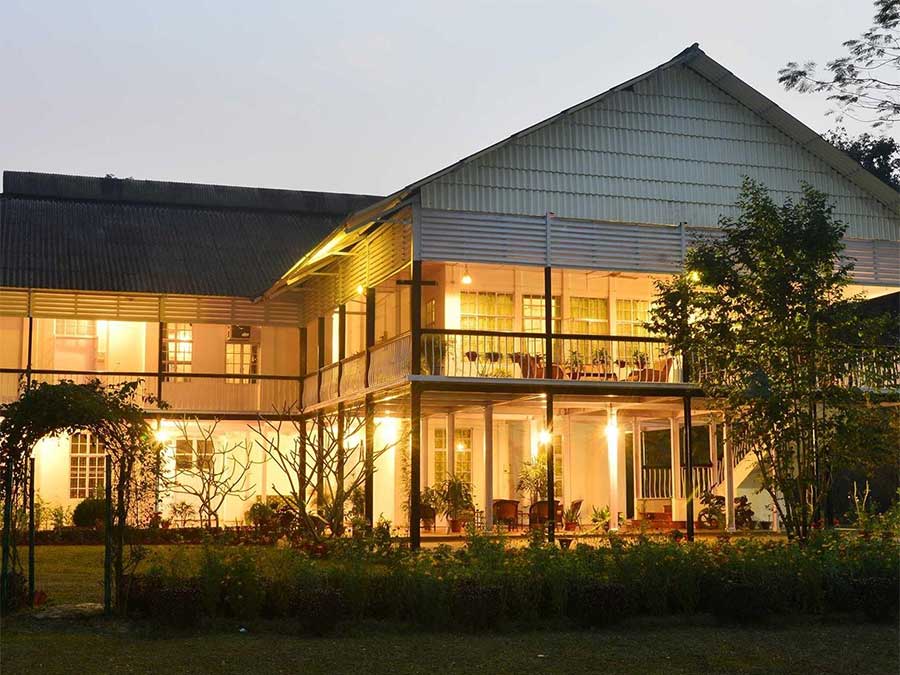
Nestled in the picturesque Cinnamora Tea Estate, this residence once belonged to Assam’s pioneering tea planter, the late Maniram Dewan. Spanning three acres and located just 15 minutes from Jorhat airport, this expansive tea bungalow offers a unique opportunity to experience life as a tea planter. Renamed Chameli Memsaab Bungalow after the filming of the 1975 movie “Madam Chameli,” it provides an affordable stay with all modern amenities.
This two-story bungalow allows guests to indulge in tea tasting and offers visits to nearby tea estates, where one can witness the art of tea leaf plucking and the various stages of tea production. The advantage lies in the reasonable rates for a delightful stay.
Moreover, the location proves convenient for a visit to the Gibbon Wildlife Sanctuary, just 45 minutes away. It’s an excellent spot to savor delicious Assamese cuisine. The Bungalow is also famous for the love story of the tea estate, between a British tea estate owner and a local tea garden worker of the tea garden here, where Berkeley a British owner, falls in love with Chameli who was a local girl who worked in the tea estate. Subsequently, they marry, however later he is blamed for her suicide. Later on, the Indi on, the Indian Assamese romantic drama film Madam Chameli created based on the Bungalow and its back story. The movie was shot in the Bungalow.
5. Thenagal Manor, Jorhat
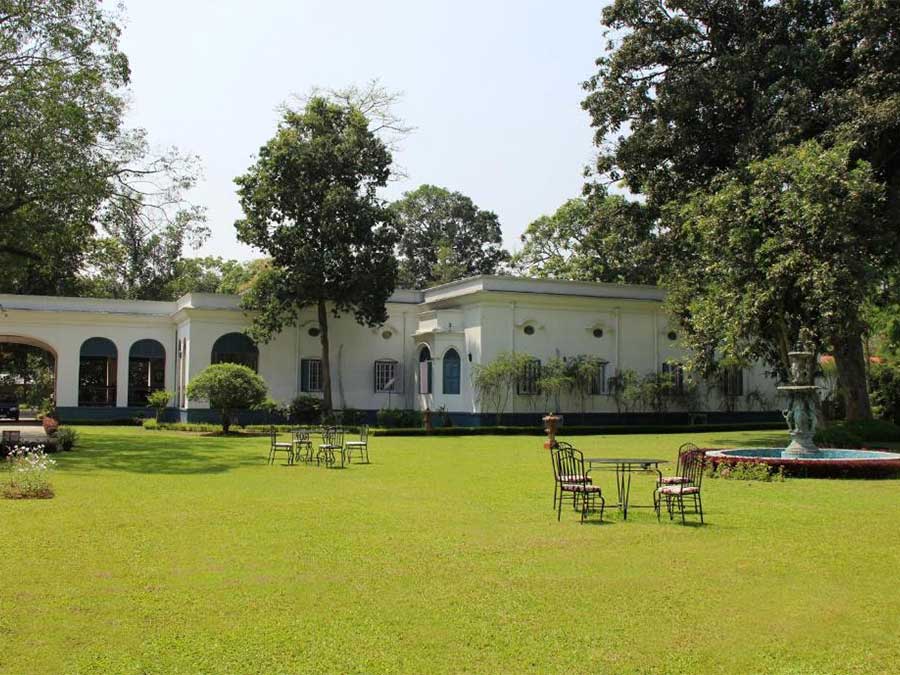
Built in 1929, Thengal Manor stands as a majestic mansion in Jorhat, deeply ingrained in history. Notably, on August 12, 1935, it marked the inauguration of the first daily Assamese language newspaper, ‘Dainik Batori.’
This historical residence provides a unique experience of gracious living surrounded by nature. It offers four double Deluxe Rooms and one single Superior Room, each featuring attached dressing rooms and baths. Every room is equipped with a fireplace, including bedrooms, drawing room, and dining room. A stroll from the regal mansion takes you to the enchanting Assamese village of Jalukonibari. Explore the homes of skilled metalworkers and master weavers, showcasing exquisite craftsmanship rarely seen beyond this village, making your visit truly exclusive.
The majestic mansion, Thengal Manor is not just the finest heritage property in Assam but a tale in itself. Constructed in 1929 by Rai Bahadur Siva Prasad Barooah, Thengal House was initially intended to house two brothers, Siva Prasad Barooah and Sashi Prasad Barooah, along with their families in a joint family setup. During that period, the house hosted around 100 people for daily meals, including numerous guests.
In 1943, a severe earthquake damaged the building, leading to temporary abandonment for repairs. The families resumed living there until 1950 when a major earthquake in the Northeast caused severe structural damage. Subsequently, the house was deserted, and family members relocated to Calcutta, Jorhat town, and the tea gardens. From 1950 to 1963, Thengal Manor remained unused until repair work initiated by Mr. H P Barooah. During this period, ancestral properties were partitioned, and Thengal Manor became part of Mr. Barooah’s family share.
Although the house underwent repairs in 1965, it remained unoccupied as Mr. Barooah had already constructed his residence, Villa Club Road, in Jorhat town. While various proposals were made by the public to convert Thengal Manor into a museum, hospital, library, college, etc., the family believed that the residential nature of the house made it unsuitable for such conversions.
6. Banyan Grove, Jorhat
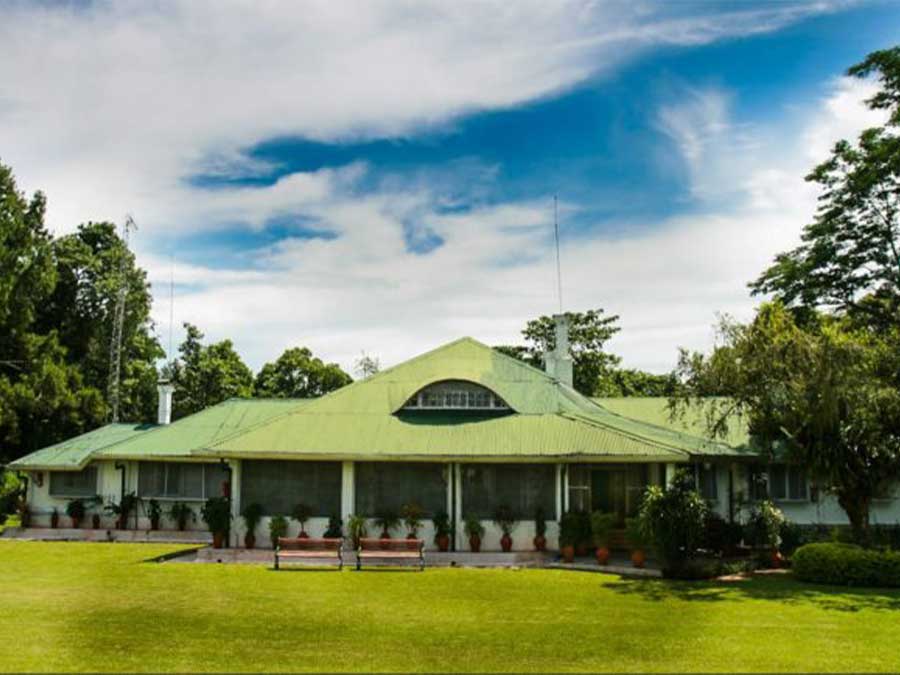
Nestled in the heart of Gatoonga Tea Estate in Jorhat, Assam, Banyan Grove stands as a heritage bungalow rich in history. Assam, known for its abundant natural resources and diverse wildlife, is home to iconic species like rhinos, tigers, and elephants. Renowned for its robust and malty-flavored Assam tea, the region offers a unique blend of comfort and natural beauty.
Banyan Grove, a heritage bungalow over 100 years old, boasts seven spacious bedrooms, each adorned with a fireplace. Guests can unwind amidst the tranquility, taking leisurely strolls in the garden and relishing specially prepared traditional North-Eastern dishes in the colonial-styled dining room.
The bungalow extends tea-plantation tours, providing insights into the art of tea making at the factory, accompanied by expert tips on tea tasting. Following this delightful experience, guests can indulge in activities such as cycling and fishing in the scenic hills of Jorhat.
With a floor area exceeding 9000 sq. ft. and a compound area spreading over 2 hectares, Banyan Grove was once the residence of the ‘Factory Assistant Manager,’ affectionately known as “Mistry Sahib” for his technical expertise. The bungalow, featuring fireplaces in all bedrooms, a spacious sitting room, and a large dining room with an attached kitchen, offers a glimpse into the gracious lifestyle of a bygone era. This property, owned by B & A Limited, the parent company, is managed by Heritage Northeast and welcomes tourists seeking a glimpse into the charm of tea garden resort bungalows during their holidays.
Conclusion
Assam’s rich tea heritage is beautifully preserved in its heritage tea bungalows and gardens, each offering a unique blend of history, culture, and natural beauty. From the luxurious Kaziranga Golf Resort in Jorhat to the colonial-era charm of Mancotta Heritage Tea Bungalow, these retreats provide immersive experiences, inviting guests to explore the intricate art of tea cultivation. The Wathai Heritage Bungalow stands as a silent historian, while Halmari and Monabari Tea Estates open their doors to tourists, offering a deeper understanding of Assam’s tea culture. Khongea Tea Estate, known for its excellent tea, provides a special journey through the tea-making process. While Manohari Tea Estate, gained fame for producing one of the world’s most expensive teas, known as “Manohari Gold Tea” or “Manohari Pearl Tea.” This tea gained international recognition for its unique production process and exquisite flavor profile. Together, these heritage destinations weave a narrative that not only celebrates the legacy of Assam’s tea but also fosters a connection between visitors and the cultural essence of this enhancing region. As these tea havens continue to welcome enthusiasts and curious travelers, they play a pivotal role in safeguarding Assam’s cultural identity and ensuring the legacy of its tea endures for generations to come.
About Protech Group
We at Protech always attempt to deliver the best properties to you with our great efforts and innovative ideas to build the ideal apartments with the best comfort and luxury in your own Guwahati city. Protech Group, with over 18 years of experience, comes with the new project of Protech Pride which is located in Bagharbari in Guwahati. To get your dream home with all the smart amenities you can reach out to us at Protech Group. To know more about us, you can click here.

